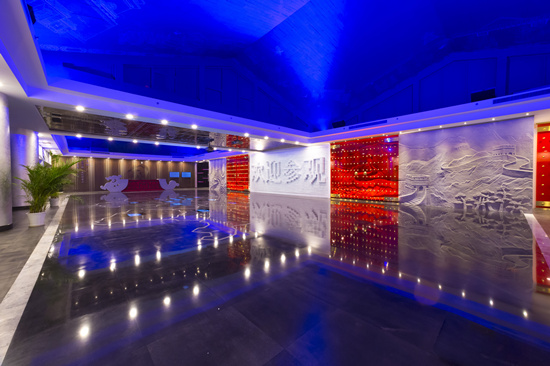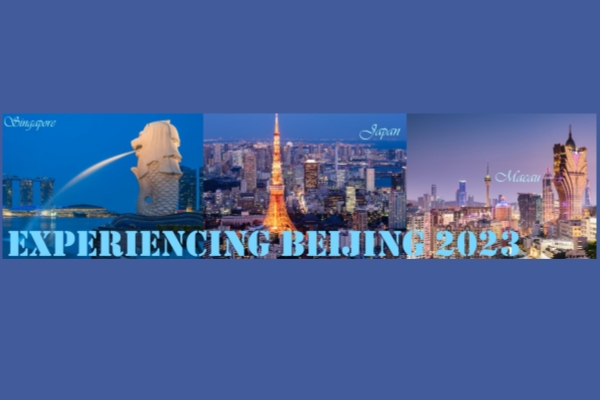Cultural flowers bloom in central Beijing
Years of renovation and re-imagining turn historical Dongcheng district into a popular destination, Yang Feiyue reports.
Xiang Yang feels her life has become more vibrant since a cultural center opened in September 2020.
She regularly visits the Meihousishi Jingshan Civic Cultural Center, which is about five minutes' walk from her home in the capital's Dongcheng district.
For example, this September, she enjoyed a monthlong cultural and drama festival, which included around 50 performances.
"It was really interesting; I have rarely watched operas before," says the woman in her 40s, who has lived in the district for more than two decades.
She also worked on making a hand-woven bracelet at the center in early September, under the guidance of an expert.
"There were a dozen students, mostly people living in the neighborhood," Xiang says. "Activities like this art project really spice up our lives."
Since the center opened, she has signed up for a variety of programs, including yoga, reading and art exhibitions.
Most are free, according to Lu Qiuping, who is in charge of operations, adding that the center has been able to deliver over 1,000 public cultural programs a year.
Among the offerings are classic movies and valuable documentaries recording the capital's development since 1860, and a permanent exhibition of historical household items from Beijing will open to the public soon.
"It is a landmark public cultural venue, and is built on a site used in the construction of Line 8 on the Beijing Subway," Lu says.
The center has one floor above ground and three underground, with a total of 21 activity spaces, including a bookstore and a theater.
"It is 5,400 square meters in size, making it the largest street-level cultural activity center in urban Beijing," Lu adds.
Sitting right behind the National Art Museum of China, it was built to enrich neighborhood culture life.
"We welcome all people regardless of where they come from. As long as they are interested in Beijing's traditional courtyards and culture, they can come here," Lu says.
Since people of different ages and professions have different cultural needs, the center has developed a comprehensive program.
"Currently, we have partnerships with 100 organizations and 500 instructors. This means that when you come here, regardless of your interests, we have the resources for you," she says.
To date, the cultural center has received more than 300,000 visits.
"The courtyard is always full of laughter and joy, especially in the afternoon after school, when children come to participate in activities, or just to play and run around," Lu says. "Adults also come for cultural rehearsals and classes. Even tourists have heard of us, and come all the way here to sign up for programs and to experience Beijing life."
The facility is one of many unused spaces and old buildings that have been transformed by Dongcheng district authorities into impressive public cultural resources.
In the process, the buildings not only get a new lease of life, but they also become closely tied to local communities, helping to deliver a range of experiences and boost the development of the district's cultural sector.
About 10 minutes' drive to the northwest of the center, the Jintai 5Lmeet cultural industry park has become a trendy destination for younger visitors in search of a mix of the traditional and the modern since it opened in March.
The site, covering an area of 4,000 sq m, lies to the north of the Bell Tower and is adjacent to the Central Axis, and was built on a site where experts from Shanghai used to work in the 1950s.
"It was affectionately called 'Shanghai lou' (Shanghai Building)," says Li Yan, who manages the park.
It was later used as office space for a municipal public institute.
"We preserved most of the historical appearance of these office buildings, when we restructured and renovated them," Li adds.
A 100-year-old magnolia tree gives the courtyard a shaded place to relax, with a number of trendy shops selling cultural creative items and art, as well as cafes, surrounding it.
"They often hold cultural activities like art and book exhibitions," Li says.
The idea is for visitors to enjoy a modern experience in historical hutong neighborhoods, where the tradition of ringing the bell at dawn and beating the drum at dusk can still be observed.
The park also has a small theater that serves as a space for young theater professionals to work.
"To date, we have worked with multiple theater teams, offering them a discounted venue for rehearsals and performances," says Fang Chao, who is in charge of the park's operations. "Theater courses here will also be open to visitors and local residents."
About 4 kilometers to the southeast of Jintai 5Lmeet, an immersive aerial experience of stunning landscapes can be enjoyed at a recently built cinema in the Longfu Temple area.
In the cinema, audiences can get breathtaking views from mountain peaks, soar above vast deserts, traverse a sea of clouds, and greet the rising sun.
"The scenes have been filmed by our team over 2,920 days. We have 100,000 km of aerial footage from 137 different locations in China," says Lyu Minghong, whose company developed the project.
"They are presented in stunning 8K, allowing audiences to virtually visit scenic spots across the country as if they were really flying."
The cinema is one of five digital experience spaces that offer simulated space and ocean travel in the Longfu Temple area.
Built in 1452 during the Ming Dynasty (1368-1644), the site was once the only temple in Beijing to accommodate both lamas and monks, and later became a famous venue for temple fairs.
The area, which has suffered from several fires over the course of history, is adjacent to the Forbidden City and the Wangfujing commercial center, and covers 15.5 hectares, and includes Longfu Temple, Longfu Square and a number of historical structures built between the 1960s and '90s.
Since 2012, Dongcheng district has been working on restoring the historical appearance of the area and on developing new urban functions, and it has become a popular destination in downtown Beijing.
The first phase of renovation started with the opening of a second M Woods Art Museum.
A few hundred meters from the museum and its neighboring art zone is a drama center, which houses a cluster of small-scale theaters, and shops around it sell souvenirs.
More exciting cultural experiences are on the way. The second phase of the restoration of the Longfu Temple area started earlier this year, and will include Chinese cultural zones and world-class museums.
"The second phase covers an area of approximately 100,000 square meters," says Wang Hui, a senior officer with the restoration project. "In the future, the area's commercial spaces will primarily serve for exhibitions and performing arts."
Construction is expected to be completed by the end of this year, and a soft opening is scheduled for next June.
The temple area, the Palace Museum, and the Wangfujing commercial district form a cultural triangle, elements of which will be featured in a digitalization project currently underway.
Augmented reality shopping, digital exhibitions and immersive digital consumption will be introduced to contribute to making Beijing an international center of consumption and a digital benchmark, Wang says.
Contact the writer at yangfeiyue@chinadaily.com.cn

 Responsibilities of the SOCAAC
Responsibilities of the SOCAAC Experiencing Beijing 2023
Experiencing Beijing 2023